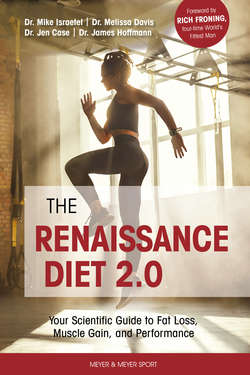Читать книгу The Renaissance Diet 2.0 - Mike Israetel, James Hoffmann - Страница 79
На сайте Литреса книга снята с продажи.
Post-Training Window
ОглавлениеTraining engages a catabolic hormonal and intracellular condition that persists for some time post-training unless a more anabolic state is attained by the introduction of nutrients. Recently trained muscles are also very sensitive to carbohydrate intake and primed to replenish glycogen during the post-training window. This effect decreases slowly over the subsequent three to six hours following training. Thus, carbohydrate intake during the six hours post training will have the greatest anabolic effects. Because the uptake of carbs into the muscle for glycogen storage is so high during this time, conversion to fat is much lower, a twofold benefit. It has also been found that fat cells are less sensitive to nutrients in the post-training window, which magnifies the post-workout nutrient consumption benefit even more. Studies suggest significant muscle glycogen resynthesis at consumption rates of 30 to 60 g per hour post exercise for the average 150-lb. person. Maximal resynthesis was seen at intakes of around 84 g per hour, but this level of intake is likely unnecessary for most individuals under most training circumstances.
If you happen to be training twice or more in one day, replenishing glycogen in the post-workout window is critical to being able to maintain glycogen levels for all training sessions that day.
There is no special role for protein in the post-workout window, aside from maintaining adequate hourly protein consumption. Fats should be kept to a minimum in the first post-workout meal as they delay digestion of carbohydrates (figure 4.10). The post-training meal should be consumed as soon as the athlete feels comfortable taking in food. Consuming mainly fast-digesting proteins and carbs in the post-workout meal supplies carbohydrates for glycogen storage and anabolism the fastest and keeps the risk of gastrointestinal distress low.
Figure 4.10 Macronutrient recommendations change across the post-training window. Upper graph: In the hours after a workout, carb needs decline while fat allowances go up. Protein needs are relatively unchanged mostly due to the smooth and stable nature of FSR curves. Lower bar graph: Bars indicate best qualitative ratios of macros for post-training meals across time.
